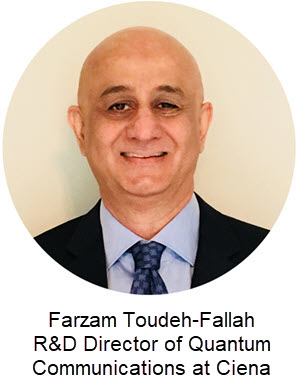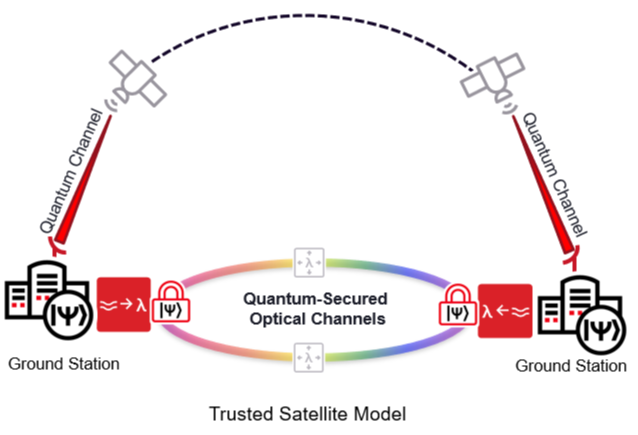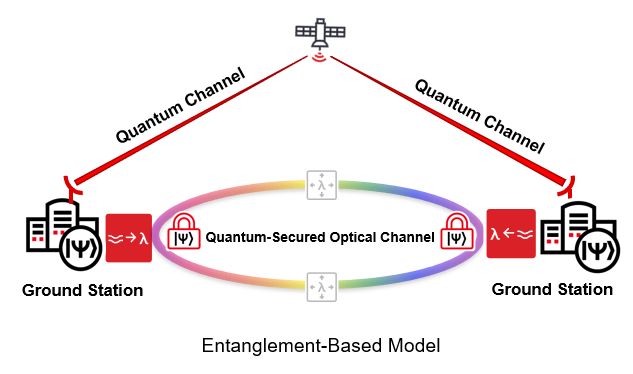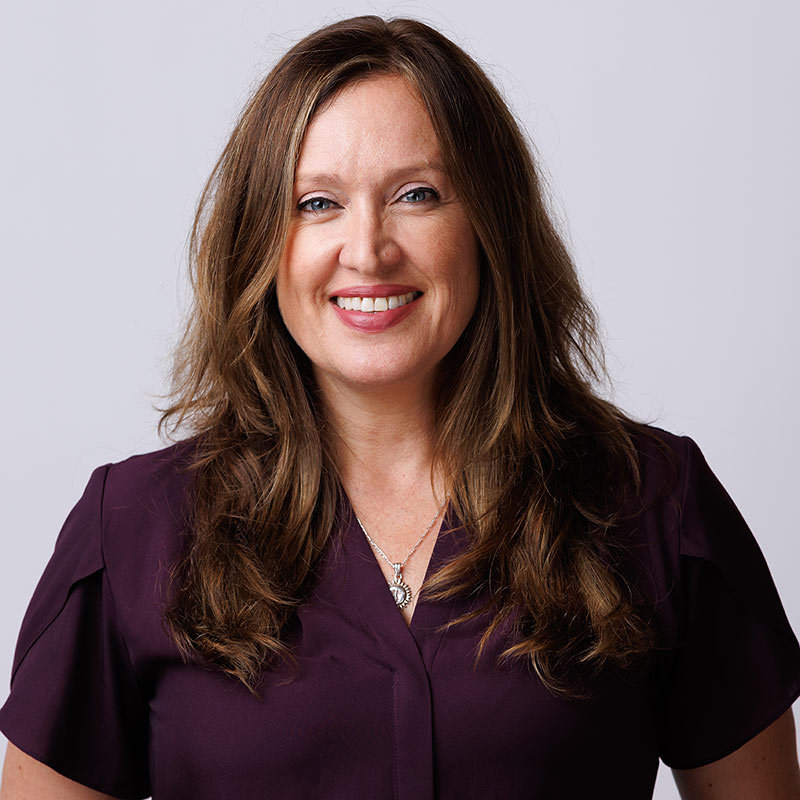Paulina Gomez speaks with Farzam Toudeh-Fallah, who leads Ciena’s Quantum Communications R&D team, about the need for quantum-secured networks and what’s next for the technology.
 Quantum computing is on the cusp of revolutionizing technology however, it also poses a significant threat to traditional cryptographic systems which compromises the security of sensitive data. For security conscious organizations and network operators handling critical data, the rise of quantum computing demands immediate action to ensure that this data remains confidential. I recently sat down with Farzam Toudeh-Fallah who leads Ciena’s Research and Development Quantum Communications team to get an update on the progress made to date in quantum-secured communications – from the role of satellites to what’s coming next from Ciena.
Quantum computing is on the cusp of revolutionizing technology however, it also poses a significant threat to traditional cryptographic systems which compromises the security of sensitive data. For security conscious organizations and network operators handling critical data, the rise of quantum computing demands immediate action to ensure that this data remains confidential. I recently sat down with Farzam Toudeh-Fallah who leads Ciena’s Research and Development Quantum Communications team to get an update on the progress made to date in quantum-secured communications – from the role of satellites to what’s coming next from Ciena.
Paulina: Why is it so important to act now to mitigate the threat of quantum computing to today’s cryptography?
Farzam: Some might argue that Q-day, when quantum computers become powerful enough to break the key exchange methods used by today’s encryption, is far into the future. However, beyond the real imminent “Harvest Now, Decrypt Later” threat, we are observing remarkable acceleration taking place in quantum computing advances. This could mean that Q-Day may be upon us sooner than we think.
An interesting example is the progress made by Google scientists on this front. In 2019, a paper co-authored by Google showed how a 2048-bit RSA integer, which constitutes one of the highest grades of today’s key exchange methodologies, could be factored in only 8 hours using 20 million noisy qubits. Fast forward to May 2025, Google published an update to this research indicating how this task could be accomplished with less than a million noisy qubits. This means that breaking RSA-2048 encryption could be achieved in under a week using fewer than one million noisy qubits - significantly reducing previous quantum computing resource estimates required to break classical encryption methods. A quantum computer capable of using less than a million noisy qubits is obviously much closer to becoming a reality than one that requires 20x as many noisy qubits. Advancements such as these reinforce the need to act now – well before practical quantum computers arrive.
Paulina: Can you explain the different approaches to help pave the way towards quantum resistant networks?
Farzam: First, I’d like to clarify an important terminology for our discussion. We define a communication channel as quantum-secured when the key distribution method used to secure that channel is based on the principles of quantum mechanics. This methodology is known as Quantum Key Distribution, often referred to as QKD.
Perhaps the most challenging area of research in quantum-secured communication and quantum communication in general is establishing long-distance quantum communication channels. This is due to the distance limit imposed by loss and other degradation factors present in the communication medium. Also, according to the No-Cloning principle of quantum mechanics, an unknown quantum state cannot be duplicated. This principle nullifies the notion of amplification in quantum communication channels. To overcome this limitation, two distinct approaches are currently under consideration by researchers:
1) Terrestrial: In this approach, a conceptual device called Quantum Repeater will be used to extend the distance of a quantum channel. This methodology is based on a unique phenomenon in quantum mechanics called Entanglement, which at a very high level could be defined as non-local correlation between quantum particles regardless of their distance. Due to the complexity of this approach, it faces several major challenges. Some examples include development of Quantum Memories capable of maintaining unknown quantum states for a relatively long period of time while operating at room temperature, achieving high fidelity entanglement and high entanglement generation rates. Although there have been some recent advances on this front, this technology is still far from the maturity level required for development towards a deployable solution for real-world operational environments.
2) Satellite-based: In this approach, a satellite in space establishes quantum channels with the ground stations and utilizes QKD methodology to generate shared secret keys between those ground stations. Those stations will in turn use the shared secret keys to encrypt a data channel between them over the fiber (or other mediums, such as free space).
Paulina: Can you elaborate on the different methods for using satellites to establish quantum-secured communications?
Farzam: Currently, there are two different methods pursued for satellite-based QKD. The first method is the Trusted Satellite Model where once the satellite generates a shared secret key with the first ground station, it moves over the second ground station and upon establishing a quantum-secured channel with that station, transfers the secret key. At this point, the two ground stations share the same secret key, which they can utilize to quantum secure a data channel between them. Of course, in practice a high volume of keys will be generated between the ground stations with each pass and not just a single key. The advantage of this method is that the two ground stations could be at any distance from each other which provides global coverage. In this methodology the satellite acts as a trusted node in space and since it is the carrier of the keys between the ground stations, the operator must trust the satellite from being compromised.
 The second method is the Entanglement-Based Model where the satellite in space only acts as a source of entangled photon pair generation. By sending those photons to the two ground stations, an entanglement-based approach to key distribution could be utilized. The advantage of this methodology is that there is no need to trust the satellite since it is not involved in the key distribution process at all and only acts as a photon pair generation node in space. However, to transmit the photon pairs to the two ground stations, the satellite must be positioned at the lines of sight of both ground stations simultaneously, which limits the ground distance between the two stations. Of course, there are some proposals to extend this coverage using methodologies such as space-based relays or utilizing higher orbits such as GEO (Geostationary Orbit). However, these are all theoretical approaches, and no practical solution exists for extending the coverage at this point.
The second method is the Entanglement-Based Model where the satellite in space only acts as a source of entangled photon pair generation. By sending those photons to the two ground stations, an entanglement-based approach to key distribution could be utilized. The advantage of this methodology is that there is no need to trust the satellite since it is not involved in the key distribution process at all and only acts as a photon pair generation node in space. However, to transmit the photon pairs to the two ground stations, the satellite must be positioned at the lines of sight of both ground stations simultaneously, which limits the ground distance between the two stations. Of course, there are some proposals to extend this coverage using methodologies such as space-based relays or utilizing higher orbits such as GEO (Geostationary Orbit). However, these are all theoretical approaches, and no practical solution exists for extending the coverage at this point.

Some major progress has been made in satellite-based QKD including a recent demonstration of key distribution using a Trusted Satellite Model between China and South Africa at a 14,000 km distance by the Micius satellite. This satellite has also demonstrated entangled photon pair distribution between two ground stations at a 1,200 km distance. In addition, several research and development efforts in satellite QKD is currently taking place across the globe including Canada, Europe and Asia.
Paulina: What is Ciena doing today to enable quantum safe communications?
Farzam: Securing critical high-capacity in-flight data in the quantum era starts with proven, high-speed optical encryption solutions – which isn’t new for us at Ciena. In fact, we’ve delivered leading optical encryption solutions to market for more than a decade. Today, our security conscious customers can use our Waveserver 5 interconnect platform for quantum-secured communications using QKD. This approach implements an external key mode of operation, compliant with ETSI QKD standards, enabling seamless interoperability with any external QKD system. This leading WaveLogic 5 Extreme (WL5e) 800Gbps encryption solution with QKD interoperability has been available for deployment since December 2023 and has been thoroughly tested with various QKD system vendors including HEQA Security, ID Quantique, LuxQuanta and Toshiba, which has led to successful customer deployments. By combining quantum keys with proven AES-256-GCM encryption, this solution ensures all critical in-flight data is secured against eavesdropping and future quantum threats.
And now we are very excited to bring to market yet another industry first - 1.6Tbps optical encryption solution backed by Ciena’s WaveLogic 6 Extreme (WL6e) coherent technology. Most importantly, it’s a complete solution to provide quantum safe communications for financial institutions, government bodies, and other stakeholders handling sensitive, high-value data. This solution integrates NIST-approved Post Quantum Cryptographic (PQC) algorithms and QKD system interworking to deliver a quantum-resistant solution capable of up to 1.6 Tbps of encrypted capacity per wavelength. Additionally, NIST-approved PQC algorithms will also be supported on our existing WL5e 800Gbps encryption solution that is deployed today.
Ciena is also conducting research on advanced technologies towards extending quantum-secured channels to long-distances, including protection of sensitive in-flight data over submarine cables. Ciena is taking two distinct approaches to extend quantum-secured channels to long-distances: 1) Terrestrial via Quantum Repeaters and 2) Satellite-based.
Paulina: How is Ciena taking the lead when it comes to satellite quantum communications?
Farzam: Although satellite quantum communication appears to be a viable approach towards establishing long-distance quantum-secured optical data channels, there are still questions we need to answer around its technical and commercial viability. Addressing these questions requires conducting extensive research, hence our engagement in the Quantum Encryption and Science Satellite (QEYSSat) research project since October 2023. This project is sponsored by the Canadian Space Agency and administered by the Institute for Quantum Computing (IQC), University of Waterloo.
As a member of the QEYSSat User Investigation Team, Ciena’s role in this project is establishing quantum-secured high-capacity optical data channels over the fiber between the two ground stations around 700 km apart. In this scenario, the secret shared keys are distributed via the satellite utilizing QKD methodology. By engaging in this research project, we aim to answer two main questions:
1. What is the technical viability of this method for establishing long-distance quantum-secured data channels? We need to understand how our optical systems, in this case Ciena’s Waveserver 5, would interface with a satellite to receive the keys. Understanding this process and how to adjust to unknown factors such as stochastic key generation rates is very important. For example, what happens if the satellite shows up over a ground station that is cloud covered? Consequently, this would mean that the quantum channel cannot be established and therefore no keys could be generated. In turn, this begs the question, what if keys cannot be generated for an extended period of time? What recourse we can take to ensure the constant flow of quantum-secured data traffic on the optical fiber link?
2. What is the commercial viability of this approach? Beyond proving the technical viability of this methodology there are several questions on the commercial aspects of this solution. What is the cost of developing, launching and controlling the satellite? What are the number of required satellites to provide a global coverage and the organization to operate the satellites?
Although there are many questions to address, we are on the right path towards getting these answers and are already recognized as one of the pioneers in this space.
After years of exploration into quantum-secured communications, it’s exciting to witness meaningful advancements and growing customer adoption—particularly in short-distance use cases. At the same time, contributing to early-stage research that will ultimately make quantum-secured communications possible across long distances is equally rewarding. Stay tuned for a blog dedicated to establishing long distance quantum-secured communications.






